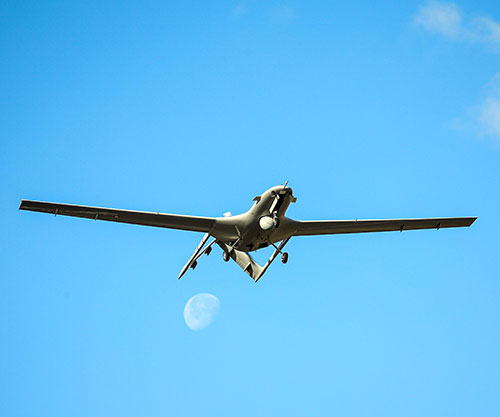The Bayraktar TB2, Türkiye’s first national and domestically developed unmanned combat aerial vehicle (UCAV), set a new record in the history of Turkish aviation by successfully completing 500,000 flight hours.
The drone completed over half a million flight hours, thus becoming the longest-serving national aircraft in the sky, the manufacturing company, Baykar, said in a recent statement.
The Bayraktar TB2 has a reputation as being the best in its class in the world based on its technical features and the operations it has been used in, entering the inventory of the Turkish Armed Forces (TSK) in 2014.
The UCAV, which was armed in 2015, is now operationally used by the TSK, the Gendarmerie General Command, the General Directorate of Security and the National Intelligence Organization (MIT). The Bayraktar TB2 UCAV has been actively deployed in the fight against terrorism within the country and across its borders by security forces since 2014.
This particular combat drone, the country’s first UCAV exported to the world, also attracts great interest from the global aviation and defense industry.
Export contracts were signed with 23 countries, including Ukraine, Qatar, Azerbaijan and Poland. Having exported $664 million in combat drone systems in 2021, Baykar became the leading exporter among companies in the field of defense and aerospace, according to the data by the Turkish Exporters Assembly (TIM).
Baykar currently generates more than 90% of its revenues from exports. Negotiations continue with many countries that are interested in buying the drone.
Bayraktar TB2 UCAVs proved effective on the battlefield after they were used by the Turkish army in Syria against Russia-backed regime forces and by Azerbaijan in recapturing its territories from occupying Armenian forces in Karabakh.
They are currently actively used by the Ukrainian army for defense purposes in the ongoing war with Russia, playing an important role in destroying Russian military gear from howitzers and tanks to air defense systems and marine platforms.
Aid campaigns were organized by the public in Lithuania, Ukraine, Poland, Latvia, Norway and Canada to buy Bayraktar TB2s and donate them to the Ukrainian army. Baykar did not accept the donations collected from the campaigns organized in Lithuania, Ukraine and Poland and instead used the funds to help the Ukrainian people meet their humanitarian needs, giving the drones to Ukraine free of charge.
The combat drone played an active role in the Hendek, Euphrates Shield and Olive Branch counterterrorism operations carried out by the TSK within and beyond the Turkish borders. Defense experts stated that the operations ended far sooner than expected and that one of the most important factors in the reduced number of casualties was the national UCAVs.
Bayraktar TB2s, which have served in many operations against the PKK including Claw and Kıran, continue to play an important role in the operations against the so-called leaders of the separatist terrorist organization. In addition to these duties, the national UCAVs also help protect the seas surrounding Türkiye, the “Blue Homeland”. In this context, it also accompanies Türkiye’s drilling ships operating in the Eastern Mediterranean from the air for safety.
Apart from military missions, they are also used in civilian missions and in response to natural disasters like earthquakes and forest fires.
Following the 6.8 magnitude earthquake that hit the Sivrice district in the eastern Turkish province of Elazığ on Jan. 24, 2020, Bayraktar TB2s were able to get to the region very quickly, as quickly as 25 minutes, and were able to transfer images and information instantly from areas that are difficult to access to authorities and command centers. In addition to supporting search and rescue efforts from the sky, the Bayraktar TB2s also helped control the heavy vehicle traffic after the earthquake and ensure aid efforts continued without interruption.
Bayraktar TB2 also assists in the documentation of human rights violations, often saving the lives of irregular migrants by following the ongoing irregular migration movements in the Aegean and Mediterranean from the sky, catching pushbacks that go against international law. It is also actively used in search and rescue activities.
















